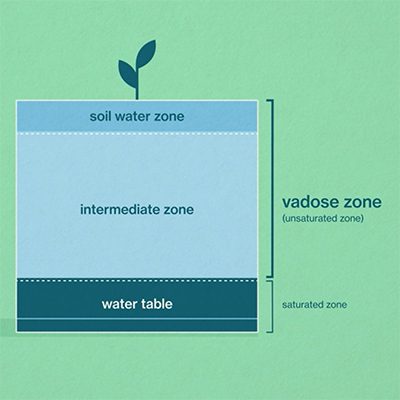Posted: 8/2/2023
Nebraska Water Center Researchers Conduct Statewide Project to Characterize Nitrogen Transformation Beneath the Ground Surface
—by Yvon Ukwishaka, SNR Graduate Student)
Surface soil, the deeper vadose zone, and groundwater are all interconnected and of particular importance due to Nebraska’s agricultural practices and reliance on groundwater for multiple uses. The vadose zone refers to the unsaturated zone above the water table, where water and air occupy the pore spaces in the soil and rock. It plays a crucial role in filtering and retaining contaminants such as nitrate before it reaches groundwater.

Over-application of nitrogen fertilizer in excess of crop needs, together with inefficient irrigation in sandy soils, can lead to the leaching of nitrate through the vadose zone and to the underlying groundwater. Despite its importance, little is known about transformation of nitrate and occurrence of other forms of nitrogen beneath the soil surface.

To help understand these processes, a research team led by Dr. Arindam Malakar, scientist and research assistant professor in the School of Natural Resources and the Nebraska Water Center part of the Daugherty Water for Food Global Institute at the University of Nebraska-Lincoln, has begun a statewide study to uncover nitrogen transformation in the vadose zone. This project is funded through the USDA Agriculture and Food Research Initiative (AFRI) program and aims to investigate nitrogen transformation in the vadose zone under various irrigation strategies and fertilizer application. With the assistance of the Conservation and Survey Division (CSD), the project started with deep coring beneath the Marie Ratzlaff Prairie Preserve and Homestead National Historical Park in Nebraska. These locations were chosen because they are representative of Nebraska geology but had not received nitrogen fertilizer or irrigation water. The cores collected will be used to create sediment columns to simulate the vadose zone changes that occur when native prairie is converted to cropland. The controlled column studies will trace the journey of nitrogen through the vadose zone under modern irrigated corn production.
Other researchers involved in the project include Dr. Daniel Snow, research professor in the School of Natural Resources and Director of the Water Science Laboratory; Dr. Erin Haacker, an assistant professor in the department of Earth and Atmospheric Science, Dr. Chittaranjan Ray, director of the Nebraska Water Center, and graduate student Yvon Ukwishaka, graduate student in the School of Natural Resources. The team hopes to gain insight into the nitrate transformations pathway within the vadose zone, which can lead the way to develop vadose zone-centric technology to eliminate nitrate even before it reaches groundwater.
